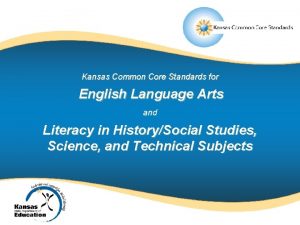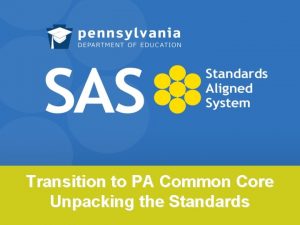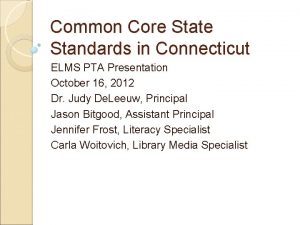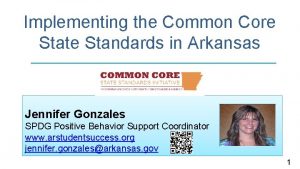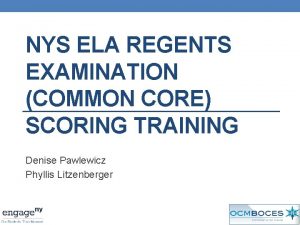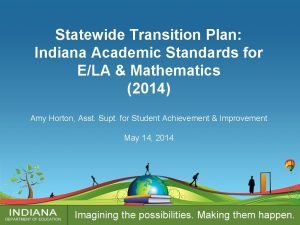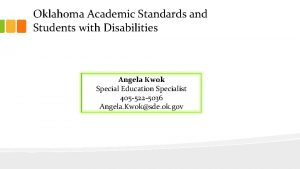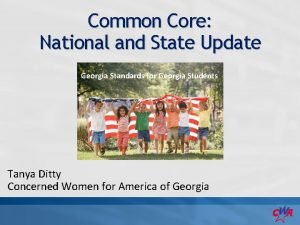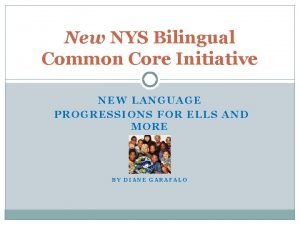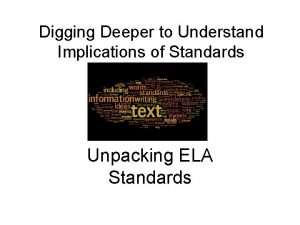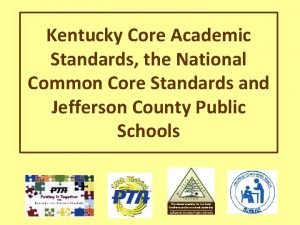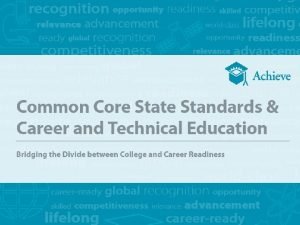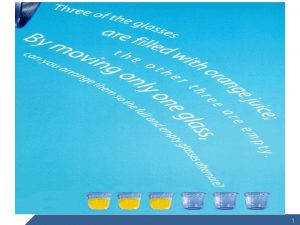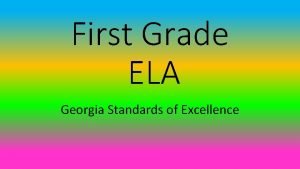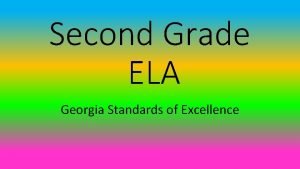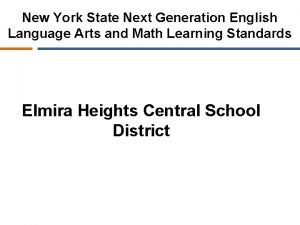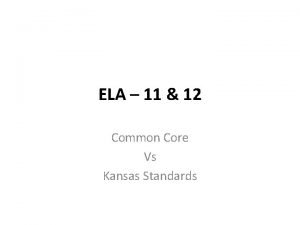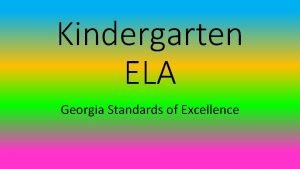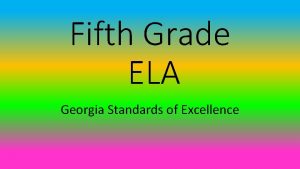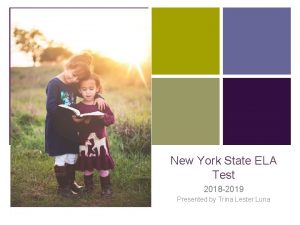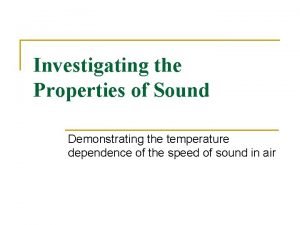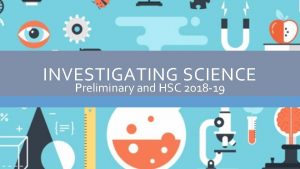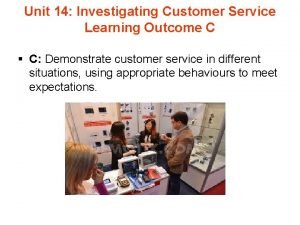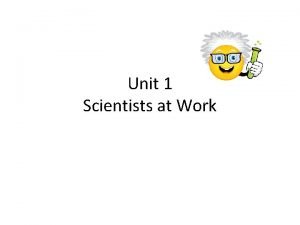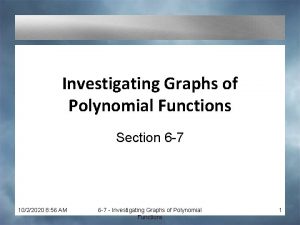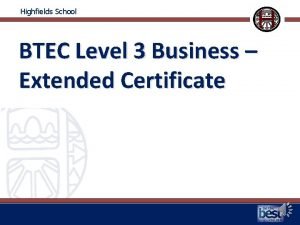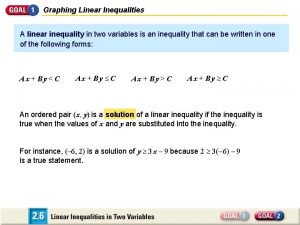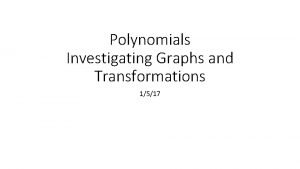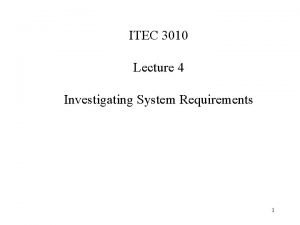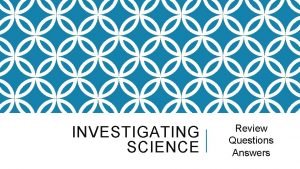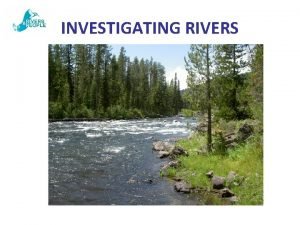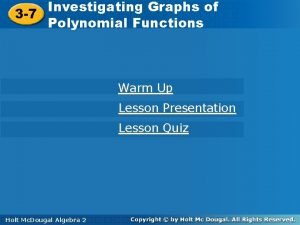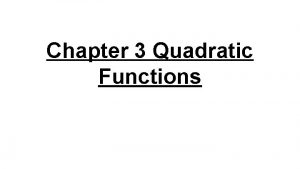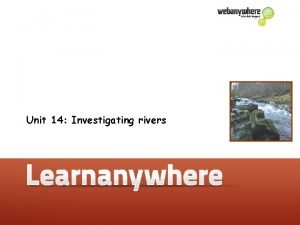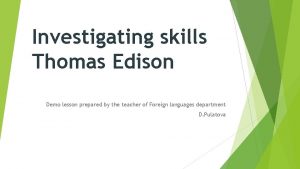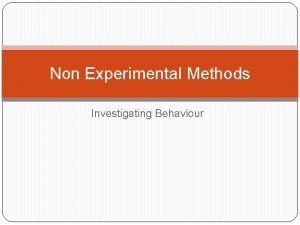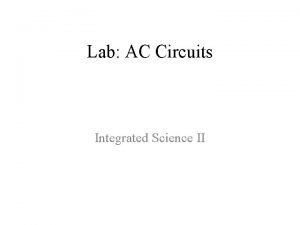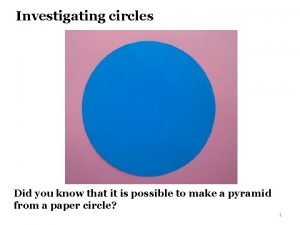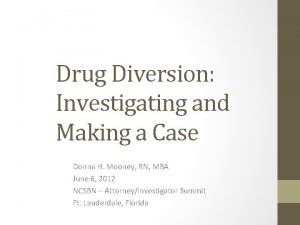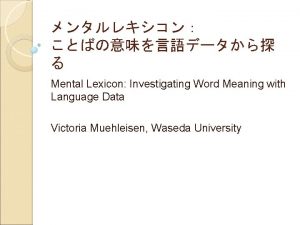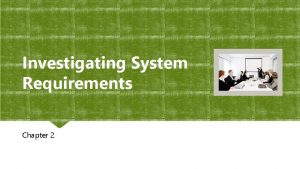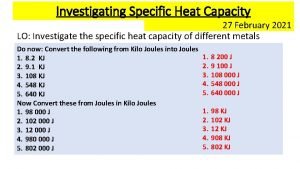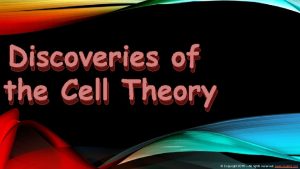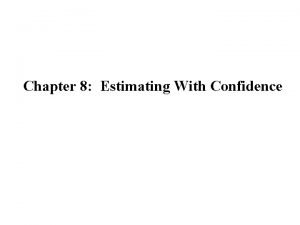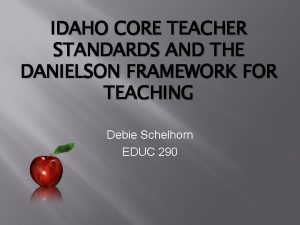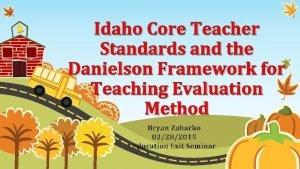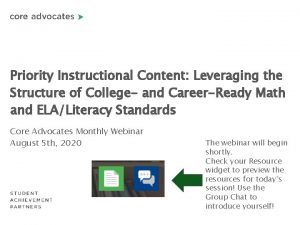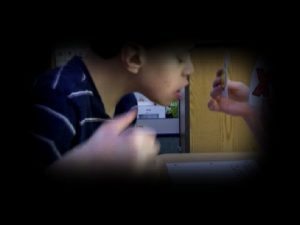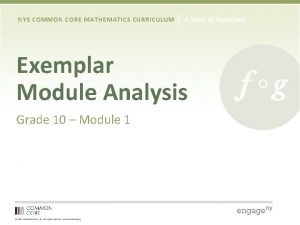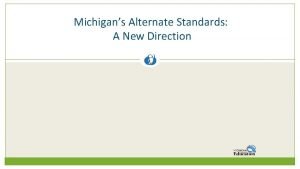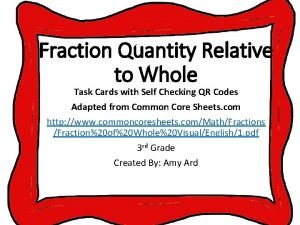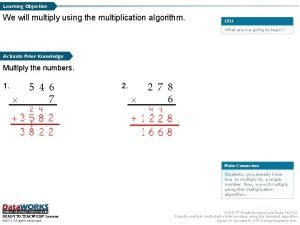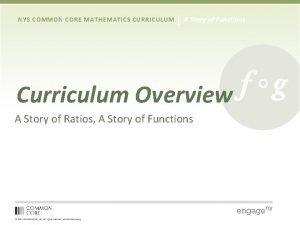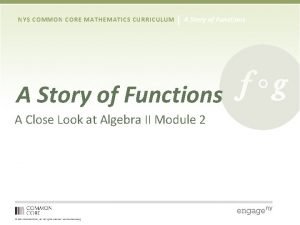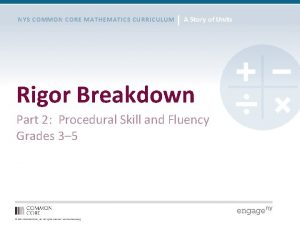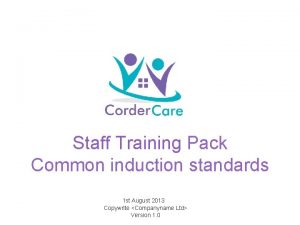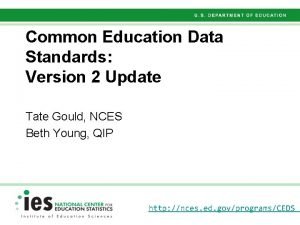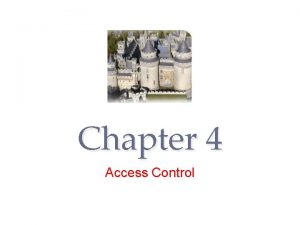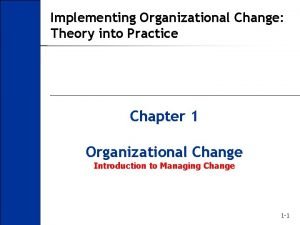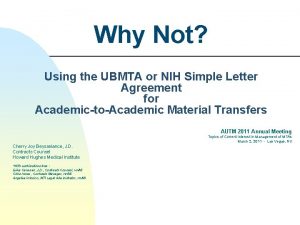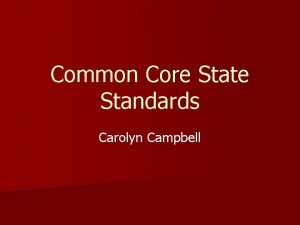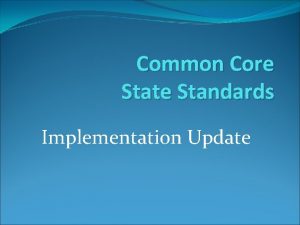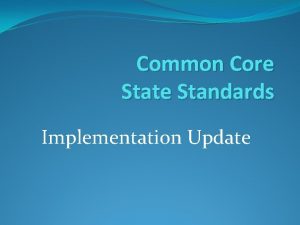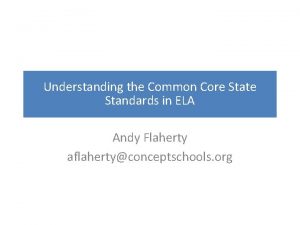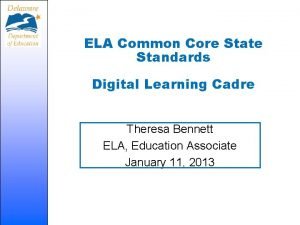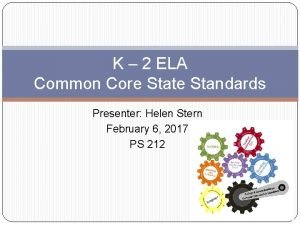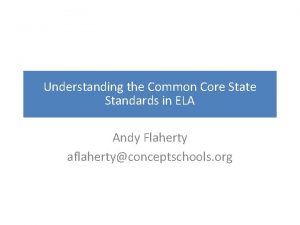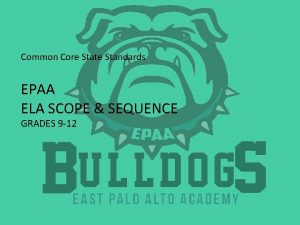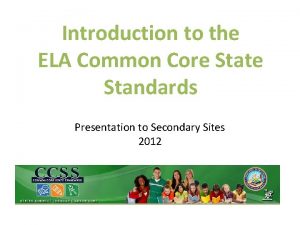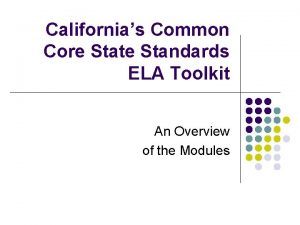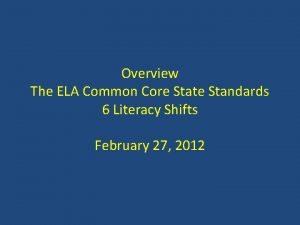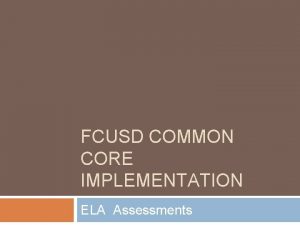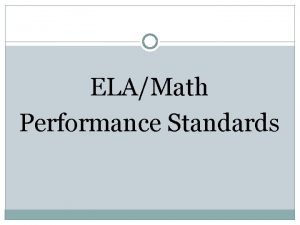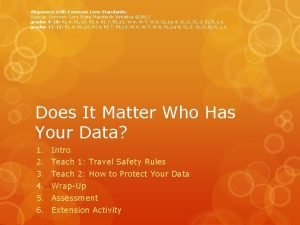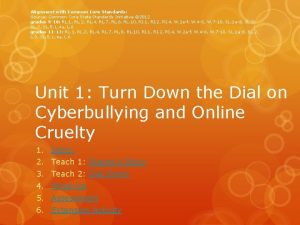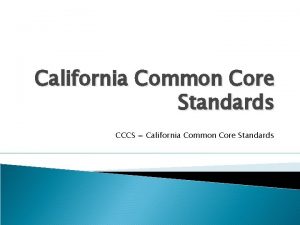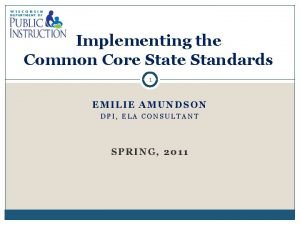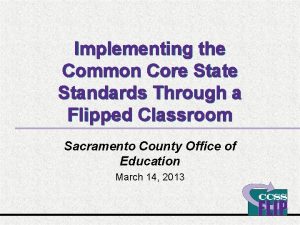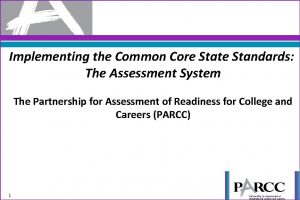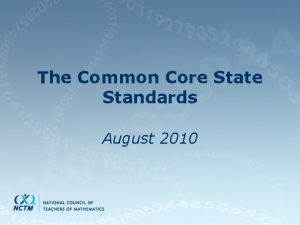ELA Investigating Implementing the Common Core State Standards
































































































- Slides: 96

ELA : Investigating & Implementing the Common Core State Standards Created & compiled by Mason-Lake & Oceana ISDs’ General Education Team

Welcome Teacher Leaders and Administrators

Why? “Professional development is critical to the overall success of the common standards. To help the stakeholders-teachers, counselors, administration, paraprofessionals-in order for them to be confident in the common core and teaching deeper into the standards, they need meaningful and supportive professional development. ” Timothy Kanold, Past President of the National Council of Supervisors of Mathematics

At your tables… What are some assumptions you have about how the CCSS are different from our current content and instructional strategies?

Outcomes • Gain a deeper understanding of the instructional shifts within the CCSS • Gain access to CCSS aligned electronic and print resources • Receive strategies to replicate and share with staff • Begin implementation process • And…

Educating Avery

What’s Already Working? If a doctor, lawyer, or dentist had 40 people in his office at one time, all of whom had different needs, and some of whom didn't want to be there and were causing trouble, and the doctor, lawyer, or dentist, without assistance, had to treat them all with professional excellence for nine months, then he might have some conception of the classroom teacher's job. ~Donald D. Quinn

Agenda • Part 1: Entering the Territory • Part 2: Clarifying and Learning • ELA Overview with Six Shifts • Close Reading with Six Shifts • Assessment Samples • Part 3: Choices and Resources • Part 4: Implementation Decisions & Action Planning

Reading like a Detective & Writing like an Investigative Reporter

Triple Track Agenda Track 1 Strategies to support your learning here in this room Track 2 Applications for implementing the ELA CCSS with your building staff Track 3 Applications for implementing the ELA CCSS in classrooms with students www. adaptiveschools. com

CCSS Quiz District Question #’s Baldwin Hart Ludington & Journey 1 2&3 4, 5, & 6 Mason County Central Mason County Eastern Pentwater Shelby & Oceana High Walkerville 6 7&8 8&9 10 & 11 12

CCSS Quiz: Answers 1. Literature Informational Foundational

CCSS Quiz: Answers 2. Foundational

CCSS Quiz: Answers 3. It is important to note that the 6 -12 literacy standards in history/social studies, science, and technical studies are not meant to replace content standards in those areas but rather to supplement them.

CCSS Quiz: Answers 4. College and Career Readiness

CCSS Quiz: Answers 5. Shared responsibility within the school

CCSS Quiz: Answers 6. Students advancing through the grades are expected to meet each year’s grade specific standards, retain or further develop skills and understandings mastered in preceding grades, and work steadily toward meeting the more general expectations described by the College and Career Readiness standards.

CCSS Quiz: Answers Grade 4 th 8 th 12 th Literature 50% 45% 30% Informational 50% 55% 70% Grade To Persuade To Explain 4 30% 35% To Convey Experience 35% 8 35% 30% 12 40% 20%

CCSS Quiz: Answers 8. Appendix A: Supplementary material on reading, writing, speaking and listening, and language as well as a glossary of key terms. Appendix B: Text exemplars illustrating the complexity, quality, and range of reading appropriate for various grade levels with accompanying sample performance tasks. Appendix C: Annotated samples demonstrating at least adequate performance in student writing at various grade levels.

CCSS Quiz: Answers 9. • Reading • Writing • Speaking & Listening • Language

CCSS Quiz: Answers 10. • Key Ideas and Details • Craft and Structure • Integration of Knowledge and Ideas • Range of Reading and Level of Text Complexity

CCSS Quiz: Answers 11. Stories, dramas, poems, myths (narrative)

CCSS Quiz: Answers 12. • Argumentative (K-5 th Opinion) • Informative/Explanatory • Narrative


CCSS and Transition • Middle (this is where we are): Neutral zone; messy & murky, chaos is common • Need Temporary Structures • Committed and Flexible

Temporary Structures

The Uncomfortable Middle Committed And Flexible

Observations Handout Same Different Gone

Key Ideas Non-Negotiable

The Assessment Consortia An Overview of the Designs of the PARCC and SMARTER Balanced Assessment Systems Pascal (Pat) D. Forgione, Jr. , Ph. D. and Nancy A. Doorey Center for K – 12 Assessment & Performance Management at ETS 27 -Dec-21

The SBAC Assessment System English Language Arts and Mathematics, Grades 3 – 8 and High School DIGITAL CLEARINGHOUSE of formative tools, processes and exemplars; released items and tasks; model curriculum units; educator training; professional development tools and resources; an interactive reporting system; scorer training modules; and teacher collaboration tools. INTERIM ASSESSMENT Computer Adaptive Assessment and Performance Tasks Scope, sequence, number, and timing of interim assessments locally determined PERFORMANCE TASKS • Reading • Writing • Math COMPUTER ADAPTIVE ASSESSMENT Re-take option Optional Interim assessment system — no stakes Summative assessment for accountability * Time windows may be adjusted based on results from the research agenda and final implementation decisions. 27 -Dec-21 Last 12 weeks of year*

SBAC: PERFORMANCE TASKS + COMPUTER ADAPTIVE ASSESSMENT • Measure the ability to integrate knowledge and skills, as required in CCSS • A computer adaptive assessment given during final 12 weeks of the school year* • Each task administered in two hourlong sittings • Multiple item types, scored by computer, including tasks • Computer-delivered, during final 12 weeks of the school year* • Results within 2 weeks • Students will have the opportunity to take the summative assessment twice • Scores from the performance assessment and the computer adaptive assessment will be combined for annual accountability scores. * Time windows may be adjusted based on results from the research agenda and final implementation decisions. 27 -Dec-21 Two Components of the Summative Assessment

SBAC: Performance Tasks One reading task, one writing task and 2 math tasks per year. Examples: • ELA: Select texts on a given theme, synthesize the perspectives presented, conduct research, and write a reflective essay. • Math: Review a financial document and read explanatory text, conduct a series of analyses, develop a conclusion, and provide evidence for it. PERFORMANCE TASKS • Reading • Writing • Math • Roughly half of the performance tasks for grades 9 through 11 will assess ELA or math within the context of science or social studies. * Time windows may be adjusted based on results from the research agenda and final implementation decisions. 27 -Dec-21 Last 12 weeks of year*

Computer Adaptive Assessment SBAC: 27 -Dec-21 Last 12 weeks of year* • Composed of approximately 40 to 65 questions per content area • Uses adaptive delivery for more efficient testing and more accurate measurement of all students, across the performance spectrum (important in measuring growth) • Scores from items that can be scored immediately will be reported, and then updated as scores from those requiring human scoring or artificial intelligence are completed COMPUTER ADAPTIVE ASSESSMENT Re-take option • Students who are approved to do so may take the assessment a second time, but will see a new set of items * Time windows may be adjusted based on results from the research agenda and final implementation decisions.

SBAC: Summative Components Last 12 weeks of year* • Student scores from the performance tasks and end-of-year adaptive assessment will be combined for each student’s annual score for accountability. • Performance tasks may begin prior to the final 12 weeks of the year, based on research studies and final implementation decisions. PERFORMANCE TASKS • Reading • Writing • Math COMPUTER ADAPTIVE ASSESSMENT Re-take option * Time windows may be adjusted based on results from the research agenda and final implementation decisions.

Common Core “Shifts” in ELA Shift 1 Pre K-5 Balancing Informational & Literary Texts Shift 2 6 -12 Knowledge in the Disciplines Students read a true balance of informational and literary texts. Elementary school classrooms are, therefore, places where students access the world – science, social studies, the arts and literature – through text. At least 50% of what students read is informational. Content area teachers outside of the ELA classroom emphasize literacy experiences in their planning and instruction. Students learn through domain specific texts in science and social studies classrooms – rather than referring to the text, they are expected to learn from what they read. Shift 3 Staircase of Complexity In order to prepare students for the complexity of college and career ready texts, each grade level requires a “step” of growth on the “staircase”. Students read the central, grade appropriate text around which instruction is centered. Teachers are patient, create more time and space in the curriculum for this close and careful reading, and provide appropriate and necessary scaffolding and supports so that it is possible for students reading below grade level. Shift 4 Text-based Answers Students have rich and rigorous conversations which are dependent on a common text. Teachers insist that classroom experiences stay deeply connected to the text on the page and that students develop habits for making evidentiary arguments both in conversation, as well as in writing to assess comprehension of a text. Shift 5 Writing from Sources Writing needs to emphasize use of evidence to inform or make an argument rather than the personal narrative and other forms of decontextualized prompts. While the narrative still has an important role, students develop skills through written arguments that respond to the ideas, events, facts, and arguments presented in the texts they read. Shift 6 Academic Vocabulary Students constantly build the vocabulary they need to access grade level complex texts. By focusing strategically on comprehension of pivotal and commonly found words (such as “discourse, ” “generation, ” “theory, ” and “principled”) and less on esoteric literary terms (such as “onomatopoeia” or “homonym”), teachers constantly build students’ ability to access more complex texts across the content areas.

Keynote Speech from David Coleman, Contributing Author of the Common Core Standards • http: //vimeo. com/24930297

Process David Coleman Please turn to a table partner: “Reading like a detective and writing like an investigative reporter with increasing text complexity. ” 1. What does this quote mean to you? 2. How do you see the six shifts impacting your classroom instruction and your students’ learning?

Break

Jot down: When introducing a new text, what percentage of your questions would be based on prior knowledge, setting purpose, making connections, etc. and what percentage might come directly from the text? • David Coleman leads a sample exploration of a complex text utilizing strategies outlined within the six shifts in instruction http: //vimeo. com/2705625 • Close Reading of Text: Letter from Birmingham Jail, Martin Luther King, Jr.

Process Close Reading • Share your notes from before the video with an elbow partner. • Based on the video and your written notes, discuss the impact of ‘close reading’ on your classroom and students. • Three volunteers to share their thoughts.

MAISA Writing Units Piloting of Opinion/Argument writing units begins December 8, 2011 • • K-5 8: 30 -11: 30 6 -12 12: 30 -3: 30 Districts will be reimbursed by the ISD for Half-day substitutes Registration may be limited due to funding; equity for district representation will be considered • Sorry, lunch will not be served; as always, feel free to bring a lunch • Piloting teachers will begin teaching the unit in December or January and will attend a follow-up writing session during the common PD day, February 10, 2012

Grade Strands Pack and Stack

Close Reading Units by grade strands • K-2 Elementary: Unpacking (Front Conference Room) • 3 -5 Elementary (5 th): The Making of a Scientist (Apartment) • Middle School: Words we Live By (South Training Room) • High School: Gettysburg Address (North Training Room)

Closer Reading Unit by Grade Strands • Purpose: • Gain an understanding of what a Common Core unit might look like • Unit to teach tomorrow • Use to inform your “tweaking” of existing units or writing new units • Think about how science and social studies might be integrated with ELA informational reading and writing

Reading like a Detective & Writing like an Investigative Reporter

A Close Reading of Richard Feynman, “The Making of a Scientist” 5 th Grade Unit • Briefly page through the unit and gain an understanding of its structure • Read the text: pages 3 - 5 • With a partner, read the detailed day 1 lesson plan, pages 6 -8 When you recognize one of the Six Instructional Shifts, put the number of the shift in the margin • Be ready to share key ideas and questions with the whole group

What are you noticing?

What are you wondering about?

Sample Performance Tasks • Read through the Sample Performance Tasks (bookmark) • How can you use the Sample Performance Tasks to inform your own teaching practice?

Notice • • Slow and deliberate Six Instructional Shifts Questions are text-based Sample Performance Tasks from Appendix B Wonder • What shifts are needed by teachers and students? • How is the layout of this unit different from your current units

Unit Exploration Please use the rest of the time to more fully explore the unit

Exemplar Unit • An example lesson that demonstrates methodology and techniques that support Common Core-based instruction, moving at a slower, more deliberate pace, while encouraging students to engage directly and in-depth with complex texts • http: //vimeo. com/27057 291 • The Gettysburg Address: A Curricular Exemplar in Literacy for High School

Where to go after lunch Assessment Samples • K-2 Front Conference Room • Brandi & Linda • 3 -5 Apartment • Tom & Kathy • 6 -8 South Training Room • Judy • 9 -12 North Training Room • Susan Please be back by 12: 25

11: 50 -12: 25

Assessments & Depth of Knowledge • Purpose: Gain an understanding of the type of assessments that will be given, and begin to understand some of the assessment vocabulary used in the Smarter Balanced draft documents

Assessment Samples • Resources for this session • Observations handout from morning • Anchor Standards handout from morning • Sample Reading Tasks: bookmarks (CCSS Appendix B) • Depth of Knowledge & Claims handout (purple) • How to Read and Interpret Assessment Targets Tables (yellow) • Grade Strand excerpts and assessments from Smarter Balanced draft documents: Content Specifications with Content Mapping for the Summative Assessment of the Common Core State Standards for English Language Arts & Literacy in History/Social Studies, Science, and Technical Subjects And Appendices A-C APPENDICES D – F Provided in Conjunction with Content Specifications with Content Mapping for the Summative Assessment of the Common Core State Standards for English Language Arts & Literacy in History/Social Studies, Science, and Technical Subjects

SBAC: Review from Morning Session PERFORMANCE TASKS + COMPUTER ADAPTIVE ASSESSMENT • Measure the ability to integrate knowledge and skills, as required in CCSS • A computer adaptive assessment given during final 12 weeks of the school year* • Each task administered in two hourlong sittings • Multiple item types, scored by Computer, including tasks • Computer-delivered, during final 12 weeks of the school year* • Results within 2 weeks • Students will have the opportunity to take the summative assessment twice • Scores from the performance assessment and the computer adaptive assessment will be combined for annual accountability scores. * Time windows may be adjusted based on results from the research agenda and final implementation decisions. 27 -Dec-21 Two Components of the Summative Assessment

5 Assessment Claims “Claims” are the broad statements of the assessment system’s learning outcomes, each of which requires evidence that articulates the types of data/observations that will support interpretations of competence towards achievement of the claims. A first purpose of this document is to identify the critical and relevant claims that will “identify the set of knowledge and skills that is important to measure for the task at hand” (NRC, 2001), which in this case are the learning outcomes for the CCSS for English language arts and literacy. Page 20 --DRAFT Content Specifications with Content Mapping for the Summative Assessment of the Common Core State Standards for English Language Arts & Literacy in History/Social Studies, Science, and Technical Subjects And Appendices A-C REVIEW DRAFT – Second Round Available

Five Major Claims for SMARTER Balanced Assessment Consortium Assessments of the Common Core State Standards for English Language Arts & Literacy in History/Social Studies, Science, and Technical Subjects Claim #1 - Students can read closely and critically to comprehend a range of increasingly complex literary and informational texts. Claim #2 - Students can produce effective writing for a range of purposes and audiences. Claim #3 - Students can employ effective speaking and listening skills for a range of purposes and audiences. Claim #4 - Students can engage appropriately in collaborative and independent inquiry to investigate/research topics, pose questions, and gather and present information. Claim #5 - Students can skillfully use and interpret written language across a range of literacy tasks.

Notice • Connection between the 5 Claims and the ELA College and Career Readiness Anchor Standards

Assessment Targets: For each Claim, a set of “Assessment Target Tables” are provided. Based on the description of sufficient evidence necessary to support each claim, the assessment targets describe the expectations of what will be assessed by the items and tasks within each claim. These summative assessment targets (evidence) at each grade level represent the prioritized content for summative assessment, and will be used to develop more detailed item and task descriptions through the item specification process. Note: Sample Assessment Targets are currently only available for grades 4, 8 and 11. Page 21 --DRAFT Content Specifications with Content Mapping for the Summative Assessment of the Common Core State Standards for English Language Arts & Literacy in History/Social Studies, Science, and Technical Subjects And Appendices A-C

Depth of Knowledge (DOK) • See Handout (purple) • With an elbow partner, read the DOK chart, marking key ideas • What does the DOK chart remind you of? • How might you use the DOK chart to inform your own classroom practice? • As you move through the sample assessments, notice the DOK.

How to Read Assessment Target Tables • Yellow Handout: Grade 4 Sample Find and read… Claim #1 The four targets The standard codes Shaded target: Claim #5 Depth of Knowledge for each target

Sample Performance Tasks • Bookmarks: Information taken from CCSS Appendix B • How might you use these Sample Performance Tasks to inform your own classroom practice?

Assessment Sample: Grades 3 -5 • Tooth Traditions From Around the World (pages 16 -17) • This assessment sample is meant for third graders • As you and your partner read through these three pages, notice the claims, targets, and DOK. How is this similar and different to your current 3 rd grade summative assessments?

Assessment Sample: Grades 6 -8 • Reading to Understand Learn: On Individual Responsibility • This assessment sample is meant eighth graders • As you and your partner read through these pages, notice the claims, targets, and DOK. How is this similar and different to your current 8 th grade summative assessments?

Assessment Sample: Grades 9 -12 Interdisciplinary Writing: Biodiesel Production, page 32 Study-Listen-Apply, page 42 Common Theme (War), page 47 Smarter Balanced: Extended Performance Event • Americans Dreaming • These assessments sample are meant for 11 th graders. • As you and your partner read through these pages, notice the claims, targets, and DOK. • • How is this similar and different to your current 11 th grade summative assessments?

Take-Out Question How will you use this assessment information as you start implementing the Common Core State Standards in your building?

Please head back to the training room

Welcome Back The Investigation Continues

Resource Review http: //Moodle. mloisd. org

Time to Change

Moving Toward Implementation üUnderstand the Change üBe the Change üHow to Change

On Your Own At the bottom of the OBSERVATONS handout there is a box titled Three Most Important Steps: November, 2011 – June, 2012 Reflect on your day of learning, and write down what you think are three most important steps your building should take between now and June 2012 to implement the CCSS for ELA.

Harnessing Common Ideas In Building Groups: Share & Categorize • 1 st person puts one idea on the table (no comments or crosstalk) • Next person puts one idea on table; if similar to first, add to pile and start categorizing • Continue the process until all ideas are shared

Two Ways of Deliberation Talking Dialogue Monitoring Self Process Whole Discussion Seven Norms of Collaboration Outcome Understanding Monitoring Self Process Details Outcome Decision Professional Community www. adaptivechools. com

Building Implementation Plans • Curriculum and Instructional Goals • Why? Rationale • Who? • Timeline • Action Steps • Teacher Evidence • Student Evidence

What Goals Can We Accomplish this Year?

Tools for Implementation • Implementation Charts (blank) • Sample Implementation • Labels for Sample Implementation Goals and Rationale • Resources from the Day

Sample Implementation Goal

ELA and Common Core State Standards: College and Career Readiness Moving Toward Implementation Understand the Change Be the Change How to Change Curriculum and/or Instruction Goal Why? Rationale Who? Materials: Shift in what students are reading – within existing materials Reading lists include a balance of literature and informational text In order to be College & Career Ready (CCR) All K-5 Teachers Source: National Assessment Governing Board. (2008). Reading framework for the 2009 National Assessment of Educational Progress. Washington, DC: US Government Printing Office. Timeline November, 2011 --June, 2011 1 -A: November. December 2. January, 2011 --June, 2011 Action Steps (may include PD) Teacher Evidence - What does it look like and sound like Student Evidence -What does it look like and sound like? 1. Audit units and books for percentage of information and literature A-Grade level meetings November and December for Jan-June classroom changes 1. A -Teachers show changes on curriculum map or other curriculum documents -Audit forms completed 1. NA 2. Substitute and/or add informational books to existing units 3. Participate in PD on informational text structures -AARI teachers? -book studies -Feb 10 Text Structure Building teams 2. Lesson plans & resources 3. PD scheduled PD resources & feedback 2. (Specific to content) Student work: reading and writing from more informational texts 3. Specific to content) New strategies and resources evident in student work

Sample Goals & Rationales




Six Month Objectives: ELA • Materials: Shift in what students are reading – within existing materials • Reading lists include a balance of literature and informational text • Teachers: Shift in student questions • Shift to 80% of questions asked as text-dependent • Students: Evidence of close reading • Close encounters with sufficiently complex text demonstrated through writing to inform or argue using evidence from text NYC schools

Building Implementation Time • Curriculum and Instructional Goals • Why? Rationale • Who? • Timeline • Action Steps • Teacher Evidence • Student Evidence

District Integration

Integrating and Reporting • Overcoming ADD • Building Goals and District Goals Conversation • 5 -10 Minutes • Create 30 second speech to answer the question “How will our district make the transition to the CCSS in ELA? ” • Goals • Timeline • Biggest Shifts • Random reporting out • Person with the birthday closest to Pi Day (3. 14 or March 14) reports out

PD Days: Feedback for Topics • MAISA Units—December 8 th • February 10 th Common PD Day: MCC • Curriculum Mapping Days • November 7 th • January 9 th • March 5 th • Summer Work: TBA

Curriculum Council Meetings th 17 • January (ELA) • March 19 th (Math) • April 24 th (ELA)

Organizing & Integrating Where are you now in your understanding of the CCSS compared to where you were at 8: 30 this morning?

Free Flip Charts for Speech Notes Principals: Please give a copy of your 30 second speech notes to Jeanne Flip Charts


Feedback Form
 Kansas ela standards
Kansas ela standards Unpacking common core standards
Unpacking common core standards Connecticut common core state standards
Connecticut common core state standards Common core state standards missouri
Common core state standards missouri Common core standards arkansas
Common core standards arkansas English regents part 3 text analysis response answers
English regents part 3 text analysis response answers Common core ela assessments
Common core ela assessments Indiana ela standards
Indiana ela standards Strrea
Strrea Georgia common core standards
Georgia common core standards Bilingual common core progressions
Bilingual common core progressions Unpack common core
Unpack common core Kcas standards
Kcas standards Common career technical core standards
Common career technical core standards Achievethecore.org
Achievethecore.org Georgia standards of excellence ela
Georgia standards of excellence ela 2nd grade gse ela standards
2nd grade gse ela standards Nys ela standards next generation
Nys ela standards next generation Kansas ela standards
Kansas ela standards Georgia kindergarten reading standards
Georgia kindergarten reading standards Elagse
Elagse 2018 nys ela test
2018 nys ela test Investigating the properties of sound
Investigating the properties of sound Investigating science hsc
Investigating science hsc Investigating graphs of polynomial functions
Investigating graphs of polynomial functions Investigating graphs of polynomial functions
Investigating graphs of polynomial functions Investigating customer service
Investigating customer service Investigating the world of work. lesson 1
Investigating the world of work. lesson 1 Investigating graphs of polynomial functions
Investigating graphs of polynomial functions Unit 14 investigating customer service assignment 2
Unit 14 investigating customer service assignment 2 Investigating the graph of an inequality
Investigating the graph of an inequality Creative imedia r082
Creative imedia r082 Investigating polynomials
Investigating polynomials Investigating system requirements
Investigating system requirements Science 14 module 1 answer key
Science 14 module 1 answer key How is a delta formed
How is a delta formed 6-7 investigating graphs of polynomial functions
6-7 investigating graphs of polynomial functions Investigating quadratics
Investigating quadratics Investigating rivers
Investigating rivers Investigating skills thomas edison cause effect
Investigating skills thomas edison cause effect Methods of investigating behaviour
Methods of investigating behaviour Integrated science lab experiments
Integrated science lab experiments What is this called
What is this called Investigating and making a case for drug diversion
Investigating and making a case for drug diversion Meaning
Meaning Investigating system requirements
Investigating system requirements Investigating specific heat capacity
Investigating specific heat capacity Cpalms investigating plant and animal cells
Cpalms investigating plant and animal cells Suppose your class is investigating the weights of snickers
Suppose your class is investigating the weights of snickers Inner core and outer core
Inner core and outer core What is the crust
What is the crust Which layer is the least dense
Which layer is the least dense Core rigidity
Core rigidity National core standards of health
National core standards of health Danielson framework summary
Danielson framework summary Bryan zaharko
Bryan zaharko Achieve the core priority standards
Achieve the core priority standards Utah core math standards
Utah core math standards Factors determining service standards
Factors determining service standards Essential elements of state
Essential elements of state Nys common core mathematics
Nys common core mathematics Essential elements michigan
Essential elements michigan Common core sheets.com
Common core sheets.com Formative assessment cycle
Formative assessment cycle 4th grade math jeopardy common core
4th grade math jeopardy common core Common core lattice multiplication
Common core lattice multiplication Nys common core mathematics
Nys common core mathematics Lesson 14 graphing the tangent function
Lesson 14 graphing the tangent function Nys common core mathematics curriculum
Nys common core mathematics curriculum Common induction standards
Common induction standards Common education data standards
Common education data standards Implementation of hrd program
Implementation of hrd program Implementing strategies management and operations issues
Implementing strategies management and operations issues Implement strategies management issues
Implement strategies management issues Implementing strategies: management and operations issues
Implementing strategies: management and operations issues The pricing tripod
The pricing tripod Retail management notes doc
Retail management notes doc Designing and implementing brand marketing programs
Designing and implementing brand marketing programs Designing and implementing branding strategies
Designing and implementing branding strategies Portfolio assessment matches assessment to teaching
Portfolio assessment matches assessment to teaching Crm project design and planning process
Crm project design and planning process Qsen teamwork and collaboration examples
Qsen teamwork and collaboration examples Challenges of implementing predictive analytics
Challenges of implementing predictive analytics Bert spector
Bert spector Implementing strategies marketing finance/accounting
Implementing strategies marketing finance/accounting Is the traditional method of implementing access control
Is the traditional method of implementing access control Problems in implementing portfolio management
Problems in implementing portfolio management Strategic business unit structure
Strategic business unit structure Flanker brand strategy
Flanker brand strategy Nfpa 1600 standard
Nfpa 1600 standard Implementing organizational change theory into practice
Implementing organizational change theory into practice Ubmta signatories
Ubmta signatories Nfpa business continuity
Nfpa business continuity Stateful firewall
Stateful firewall Implementing strategies management and operations issues
Implementing strategies management and operations issues What is the greatest common factor of 12 and 42
What is the greatest common factor of 12 and 42 Common anode and common cathode
Common anode and common cathode
